When The Feedsack Dress came out in 2007, I started a blog on Typepad that focused on life during the late 1940s and early 1950s. I stopped posting there in 2012, but you can still link to The Feedsack Kids. I’m posting some new blogs and my favorite old ones here.
Category Archives: Events
Prime Promotion Season Ends
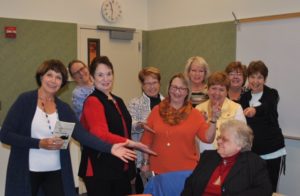
Bookies Book Group
Part of a novelist’s job is promoting, and promotion took more time than usual this fall. After all, the approach of winter was a good time to talk about my last book, Show Me the Sinister Snowman.
Reminder: Still time to buy a copy as a Christmas gift.
Most of my promotion is more subtle than that. For example, in October I took a mental vacation from being an author and prepared a lecture on novels that have had an impact on society for the local Osher Lifelong Learning Institute. Naturally I gave attendees an opportunity to buy copies of all seven of my novels.
October is prime conference time. I served as a panelist and a panelist/moderator with some of my favorite writers, including Kent Krueger, at Magna cum Murder in Indianapolis. That enjoyable (and tax deductible) annual event offers opportunities to have in-depth conversations with other writers and with readers.
The last weekend in October, I split my time between the regional library’s Local Authors’ Day and the innovative ShowMe MasterClass co-sponsored by the Columbia Chapter of the Missouri Writers’ Guide and Mizzou Publishing. My contributions to the latter were mentoring two aspiring novelists and speaking on polishing a manuscript.
In November I used my leftover research on Thunder Beneath My Feet to give a talk about the disastrous New Madrid earthquakes of 1811-1812 at the Senior Center. I’m afraid my descriptions and anecdotes alarmed them about the quakes to come (no one knows when). Several vowed to modify their home insurance to include earthquake coverage.
A week later, I covered some of the same material and answered lots of questions in a long conversation with members of the Bookies, an enthusiastic book club. I never get tired of talking with readers.
Off and on through these and other events, I worked on polishing the manuscript of the first book in a new series. Appearances over and manuscript finished, I’m looking forward to my favorite season, working on my next mystery.
—Carolyn Mulford
Celebrating Show Me the Sinister Snowman
Readers will join me in celebrating the publication of Show Me the Sinister Snowman at 2 p.m. tomorrow, Saturday, May 20, at Columbia Books, 1907 Gordon Street, Columbia, MO.
Today I’ve been thinking about what to say to them between their browsing among the new and antiquarian books and nibbling on refreshments. Sinister Snowman is the fifth book in the series, so most people there will have read at least one of the books. What do they want to know about the series and the new book?
Beats me, but those who come to these book launches always ask lots of questions. I’ll answer them gladly and, unlike my protagonist, truthfully.
To set the stage for questions, I’ll speak briefly about changes in the lives of the three main characters—former CIA covert operative Phoenix Smith, widowed small-town socialite Annalynn Carr Keyser, and struggling singer/music teacher Connie Diamante—over the seven months in which the five books take place.
I also usually do a short reading. I’ve been debating whether to read from a humorous scene in the first chapter or an unpublished blog written in the voice of many readers’ favorite character, K-9 dropout and faithful sidekick Achilles. In all the books the Belgian Malinois shares the front cover with Phoenix and her Glock. I’ll decide tomorrow.
If you can’t come, you can read the first chapter by linking to the book’s page from under Show Me Mysteries on the navigation bar. I’ll give a link to the blog next week.
The great thing about book launches is talking to readers face to face rather than just on the page.
—Carolyn Mulford
Thunder Beneath My Feet Wins Award
Last night the Missouri Writers’ Guild recognized Thunder Beneath My Feet with third place for the Walter Williams Major Work Award. The honor rarely goes to a middle grade/young adult novel.
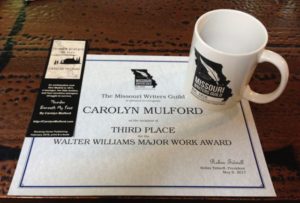
Missouri Writers’ Guild Award
Named for the founder of the world’s first School of Journalism and of the Guild, the Major Work Award goes to publications or productions judged “to be worthy of special recognition because of the research or high literary quality involved in its creation.” It is the top award given each year at the annual meeting.
Show Me the Murder won first place in 2014.
—Carolyn Mulford
Marching in the 1993 Inaugural Parade
Today’s presidential inauguration reminded me of the good and bad in taking part in the inaugural parade 24 years ago.
As the 1992 presidential campaign wound down, the Washington, D.C., chapter of Returned Peace Corps Volunteers asked if members would like to march in the inaugural parade.
Like most locals, I avoided going near the Mall when the crowds came to town, but I couldn’t resist the chance to take part in this national event. Neither could Joyce Campbell, another RPCV from the 275-strong Ethiopia I group. We signed on.
We waited weeks to hear whether an RPCV with political connections could convince the parade organizers to allow us to publicize the Peace Corps. Twenty-two years after its founding, some 150,000 had served, but many people had forgotten about this one-to-one foreign aid program. (Today more than 7,000 PCVS are serving, and 225,000 RPCVs have served in 141 countries.)
The parade was to begin at 2 p.m. At 8:30 a.m., Joyce and I met to ride the Metro from Silver Spring, Maryland, through D.C. into Arlington, Virginia. We met our group—about 100 RPCVs who had served in 50 or so countries—in the enormous Pentagon parking lot.
After learning our assigned positions, we boarded buses and rode to our waiting spot on the Mall near the Museum of American History (at least a half mile from the Capitol). The buses dropped us off around 10:30, leaving us to mill around with no place to sit.
The temperature was near freezing, and the sun shone halfheartedly. Having worn a heavy sweater beneath a super-warm coat and warm hiking socks under snow boots, I stayed warm as long as I kept moving.
At noon, speakers broadcast the inauguration ceremony and, memorably, Maya Angelou reading her poem. Then the new president and Congress had lunch in the Capitol. We ate box lunches in the cold.
We didn’t line up with our flags until well after 2, and we didn’t move for another hour. Instead of going all the way to the Capitol, we cut left to Pennsylvania Avenue around 4th Street. The crowd had thinned out by then (coming up on 4 p.m.).
Joyce, a later Ethiopia RPCV, and I took turns carrying the heavy, long-poled Ethiopian flag. A nearby band gave a beat to march to as, adrenalin flowing, we moved at an irregular pace up Pennsylvania toward the White House.
With the sun dimming, we turned onto the last block and saw nearly empty bleachers across from the president’s viewing stand. He’d delegated greeting the marchers to the vice president. Al Gore, the only one in the viewing stand focused on the parade, gave us a big thumbs up.
Our group broke up right after we passed Blair House. We turned in the flag at the waiting bus and headed for the nearest Metro stop.
Like the Peace Corps, the inaugural parade had been tiring and taxing, but being part of the Peace Corps for two years and of a historic transition for one day had been well worth it.
—Carolyn Mulford
Killing Chickens
I wrote The Feedsack Dress to portray life as the era of the unmechanized, pre-electricity family farm ended. Readers view late 1949 through the eyes of a 13-year-old farm girl called Gail. Like the nation, she is making a major transition, in her case from the small one-room school to the much larger junior high in town and from the homemade feedsack dress to ready-made clothing.
Saturday the Sullivan County (MO) Historical Society invited me to help celebrate a special exhibit of clothing made from patterned cotton sacks. I read a scene in which Gail and her mother perform a then familiar and unforgettable chore: chasing down, killing, and plucking chickens to fry.
Gail’s mother, like mine, used the chop and toss method. She held the chicken down on a stump, cut off the head with a hatchet, and threw the blood-spurting chicken a few feet away to jerk around until the heart stopped. Then Gail picked it up by the legs, dunked it in a bucket of hot water, and held the carcass at arm’s length to pull out the stinking feathers.
Several women shared some of their childhood memories, including the following.
*** One’s mother killed a chicken by putting a sharp-edged coffee can over the head and stepping on it.
*** A common killing technique was holding the chicken by the head and swinging it round and round until either the head came off or the neck was wrung.
*** One person always put the chicken’s neck between two nails driven into a board to hold the head in place for the hatchet.
*** Some people hung a beheaded chicken from the clothesline while the blood ran out.
*** Another mother refused to kill a chicken. The father always did it.
*** A nauseating odor greeted you when you cut open the chicken and disemboweled it.
*** The rural letter carrier delivered big boxes of baby chicks in the spring. By mid summer, families ate fried chicken several times a week.
*** Strong odors, including from the necessary place (outdoor toilet) and cow manure, were more common and less remarked upon then. One woman recalled milking a cow by hand each morning and sometimes going straight from the barn to catch the school bus.
*** The sacks in which you bought sugar or flour were a finer weave than those in which you bought chicken feed. Underwear made from coarse feedsacks was scratchy.
*** All of us farm girls learned to drive a tractor—often having to stand on the clutch or brake to make it work—years before we drove a car.
*** In the 1930s and 1940s, almost everyone used feedsacks to make clothing, tea towels, and quilts.
Most farmers had a small flock of hens up into the 1950s. They provided fresh eggs to eat and to sell, meat to fry in the summer and bake or stew in the winter, and chores for kids all year round. As a fringe benefit, the feed came in pretty sacks now treasured by collectors and quilters.
—Carolyn Mulford
Double Book Launch May 21
A few years ago I was discouraged because I couldn’t find a publisher for my mystery series. I decided to take a break and write the kind of a book I loved as a kid, a historical novel.
I considered several ideas, including a book on the Civil War in Missouri, but that depressed me. I chose to write fiction about a topic I’d written about as nonfiction, the New Madrid earthquakes of 1811-1812. I loved writing the book, Thunder Beneath My Feet, but no one rushed to publish it.
Then I sold Show Me the Murder, the first of my mystery series. I put aside marketing my historical novel. I sold three other mysteries before I went back to my middle grade/young adult novel and found a publisher.
Tomorrow Columbia (MO) Books will host a joint book launch for Thunder Beneath My Feet and Show Me the Ashes, my tenth and eleventh books.
If you’re in or near Columbia, drop by Columbia Books (1907 East Gordon) at 2 p.m., Saturday, May 21, for a short talk/readings, refreshments, and conversation amid new and antiquarian books.
—Carolyn Mulford
Book Talks: April-June 2016
Most of these events feature one of my two new books, Thunder Beneath My Feet, a historical middle grade/young adult novel set during the New Madrid earthquakes, and Show Me the Ashes, the fourth in my mystery series featuring a former CIA covert operative solving crimes in rural Missouri.
April 7, 7 p.m.: An Evening with Local Authors, Barnes and Noble, Columbia (MO) Mall
Marlene Lee, Cathy Salter, and I discuss writing and read from our new books.
April 24-25: Missouri Association of School Librarians Conference, Tan-Tar-A Resort, Osage Beach
As an exhibitor/vendor, I’ll be chatting about Thunder Beneath My Feet and The Feedsack Dress for students and the Show Me mysteries for librarians.
April 29-May 1: Malice Domestic, Hyatt Regency Hotel, Bethesda, MD
10 a.m., Friday: Malice Go Round
Authors will move from table to table to give a two-minute sales pitch for their books. I’ll focus on Show Me the Ashes.
3 p.m., Saturday: Start ’em When They’re YAs
A panel discusses capturing middle grade and young adult readers. Other panelists are Sarah Masters Buckey (moderator), Shelly Dickson Carr, Kathleen Ernst, and Nina Mansfield.
May 7, 2-3:30 p.m.: Reading/signing, Hastings, 1800 North Baltimore, Kirksville, MO
At 2:30 p.m., I’ll speak briefly about why I write both mysteries for adults and historical fiction for young readers and read short passages from Thunder Beneath My Feet.
May 14, 9:30 a.m.: “Writing Your Own Novel,” AAUW Independence Branch Brunch, First United Methodist Church Fellowship Hall, 400 West Maple, Independence, MO
I’ll give tips on drawing on life experience and developing new skills to write a novel.
May 28, 1:30-3:30 p.m.: Reading/signing, Old Timers Reunion, Sullivan County Historical Society, 117 North Water Street, Milan, MO
At 2 p.m., I’ll speak on why I wrote The Feedsack Dress, read short excerpts, and answer questions about that and my other books.
June 4-5: Authors’ Booth, Columbia Chapter of the Missouri Writers’ Guild, Art in the Park, Stephens Park, Columbia, MO
I’ll read from one or more of my books (specific time and place not set).
June 11, 10:30-11:30 a.m.: Signing, Edna Campbell’s Gift Shop, 105 West Washington Street, Kirksville, MO
June 18, 9:30 a.m.: Meet the Author, Boone County Historical Society, 3801 Ponderosa Street, Columbia, MO
I’ll discuss why I wrote Thunder Beneath My Feet and how I researched the New Madrid earthquakes and the community.
June 29, 11:15 a.m.-12:45 p.m.: “The Shocking New Madrid Earthquakes,” Wednesday Mixed Bag Series, Osher Lifelong Learning Institute, Moss Building, Hillcrest Community Center, Columbia, MO
I’ll share my research on the New Madrid earthquakes and life in Upper Louisiana Territory in 1811-1812 and explain how I turned fact into fiction.
Show Me the Ashes Released
You won’t find Show Me the Ashes in stores or libraries for a few days, but Five Star/Gale, Cengage shipped hardbacks to distributors March 16. The e-book went up immediately on Amazon.
In this fourth book in the series, former covert operative Phoenix Smith divides her attention between a cold case and a hot one.
Now running a foundation to assist crime victims, Phoenix listens to a desperately ill woman’s plea to prove her daughter was sent to prison because of a coerced false confession to manslaughter and arson. The sheriff then was the adored husband of Phoenix’s best friend, Annalynn. She has served as sheriff since his violent death. Phoenix begins a preliminary investigation without telling Annalynn.
With her term almost over, Annalynn focuses on solving a series of increasingly ominous burglaries. Naturally she enlists the help of Phoenix and Achilles, her K-9 dropout. Some wants Achilles and Phoenix dead. She must solve both cases to protect them and others.
—Carolyn Mulford
Talking About My Books
The work on a book doesn’t end when it’s published. Saturday morning, July 11, I’m performing one of the most pleasant of the follow-up tasks: talking to people who have read Show Me the Gold or think they may.
I’ll hold the floor for an hour at the monthly Osher Saturday Morning Book Talk, Room D, 1907 Hillcrest Drive, Columbia, MO. Readers gather for coffee (included in the $3 admission) and pastry at 9:30 a.m. The show begins a little before 10. A group of mystery fans, the Ashland Mystery Book Club, is sponsoring my talk.
What do these readers want to know? Organizer Kit Salter tells me they’re curious about the writer as well as the book. I’ll touch on how and why I finally became a mystery writer.
Series dominate mysteries, so I anticipate interest in the origin and development of my Show Me series. Most of the rest of my prepared talk will cover my characters and themes, most particularly in Show Me the Gold. If I don’t talk too much, I’ll read short passages to illustrate points and give a flavor of the writing.
To make sure the readers hear what they want to know, we’ll end the talk with a Q&A and hang around for signing and chatting.
No part of the publication process gives me greater pleasure than the writing, but talking to readers comes close.
—Carolyn Mulford
Book Launch for Show Me the Gold
Readers, writers, and others with nothing better to do are invited to come celebrate the publication of Show Me the Gold at 2 p.m., Saturday, January 24, Columbia Books, 1907 Gordon Street, Columbia, Missouri.
We’ll have conversation and refreshments before and after a short presentation. I’ll talk for a few minutes about how the series has developed and why mystery writers and readers like series. I may even look ahead to book four (now beginning the production process) and book five, now in the early chapters of the first draft.
And, of course, guests can ask questions about the books or the writing of them. We had a stimulating Q&A at the book launch for Show Me the Deadly Deer a year ago.
The host, Columbia Books, is an independent bookstore that sells new, used, and antiquarian books and small items with special appeal to booklovers.
To get there from East Broadway, turn north on Old 63 (just east of Boone Hospital), and in about a mile turn right on Gordon. If you approach on Business 70 East, turn south on Old 63 (a little east of Paris Road) and in .2 mile turn left onto Gordon.
—Carolyn Mulford
Glimpses of Chile
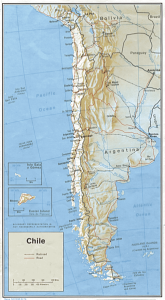 For decades I traveled Peace Corps style: riding buses and trains, staying at B&Bs and austere hotels, and buying most of my food in markets and small restaurants. Traveling on a low budget took extra time, planning, and effort, but it enabled me to experience life in unfamiliar countries somewhat as the natives did.
For decades I traveled Peace Corps style: riding buses and trains, staying at B&Bs and austere hotels, and buying most of my food in markets and small restaurants. Traveling on a low budget took extra time, planning, and effort, but it enabled me to experience life in unfamiliar countries somewhat as the natives did.
Gone are the days. I’ve reconciled myself to touring with a group of curious, well-traveled retirees on two-week trips planned and directed by people who make sure hotels and restaurants meet high standards and know where to find a bathroom every two hours.
In November I took such a tour of Chile and Argentina, two countries I’d avoided in my do-it-yourself days because their governments made lots of people disappear. Comfort, congenial companions, and the organizers’ good mix of places and personal encounters made the trip enjoyable and stimulating.
What we saw and heard aroused my journalistic curiosity. I can’t satisfy that, but here are some glimpses of things in Chile that intrigued me.
Protests in Santiago
Although we saw the shacks that trumpet poverty on the way from the airport, most of Santiago looked like a pleasant modern city. Jacaranda bloomed in parks. Well-dressed people (almost all white) rode a clean, quiet subway. Restaurants (seafood is huge) and ice cream places abound. We had some really good ice cream in unfamiliar flavors, and lots of young (and not so young) people were eating cones in the street.
We saw many new high-rise apartment buildings, some near blocks of old mansions that had been turned to other uses—businesses, apartments, schools. Despite a high literacy rate, quality education is more goal than reality, we heard, with the public schools bad and the private ones expensive.
The most surprising, and encouraging, thing to me was the number of protests. For years after the 1973 CIA-assisted coup that ended with leftist president Salvador Allende’s death, protestors tended to vanish. Thousands of others fled the country, with some returning after the repressed but more prosperous citizenry astonished General Augusto Pinochet by voting him out of office in 1988. (The United States gets some credit for helping Chile improve its economy.)
When we went for a walk in the central area, unionized government workers were gathering with signs to push the legislators to put a pay raise in the new budget. Stilt-walkers and drummers added a festive air. We saw small groups of protestors marching in the street several times. Police were plentiful but not obtrusive. They didn’t wear riot gear or carry military arms.
My cynical reportorial self wondered—but couldn’t investigate—who really staged these peaceful scenes.
A British tourist told me he saw a different scene from his hotel window early one morning. Police used water cannon against a group of young protestors, targeting one man in particular. A Chilean said he was probably an anarchist making trouble. A defensive excuse? Probably, but anarchists (like looters) do mix with protestors.
Put the protests in Santiago in context. International television news was showing report after report of looters and arson in Ferguson, Missouri. For months the area police had shown they didn’t know how to handle demonstrations. When I lived in D.C., people were brandishing signs whenever I passed the White House.
Lakes and Volcanoes
One reason for the trip was to see Andean scenery. The warm-up was Chile’s low-lying agricultural heartland, where grapevines, fruit trees, and corn often line the highway. The first two provide major exports. I can testify that the fruit was excellent. My companions enjoyed the wines. As to the corn, it forms a major part of the local diet, turning up in casseroles, stews, and salads.
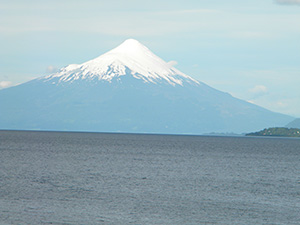
Osorno Volcano
The most scenic area was to the cooler south around the pretty Patagonian resort town of Puerto Varas. Here our hotel looked across the huge Lake Llanquihue to the snow-topped, cone-shaped Osorno and the long, irregular Calbuco volcanoes. A few years ago an eruption spewed masses of sand-colored ash, most of which drifted east into Argentina. A ten-inch layer of ash drove nearby residents away and killed forests, crops, and the tourist trade. People have returned to the towns, and their beautiful gardens attest to the ash’s nutritional properties.
We made several interesting side trips.
• A horse-breeding ranch where huasos, a father and son, showed how they compete in rodeos quite different from ours. No roping, no bull riding, no bucking broncs. Competitors receive points for maneuvering a steer cuddled between their sidestepping Andalusian horses in prescribed patterns without harming it. Dressed in traditional garb that includes a flat-brimmed hat and a heavy, hand-woven poncho in the ranch’s colors, the horsemen eschewed lassos, and their large, round-tipped spurs didn’t harm the horses. A kinder and gentler rodeo tradition.
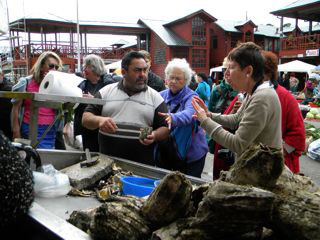
Market in Puerto Montt
• A Saturday market in Puerto Montt where shoppers found a variety of fresh seafood, large vegetables, and such other items as cheese. One of our most intriguing finds was a picoroco, a barnacle. The gray, tulip-shaped shell contained a white mass that shoppers took home or ate at the vendor’s stand with lemon juice. I preferred one of Chile’s favorite staples, empanadas. Turnover-sized and shaped, the empanadas held ground meat and potatoes, seafood, or cheese. In the market we saw some Native American faces.
• Petrohue Falls, a national park where green water from a lake rushes through lava formations. The low falls don’t equal the Great Falls of the Potomac near D.C., but the view of snow-capped volcanoes in the distance adds beauty.
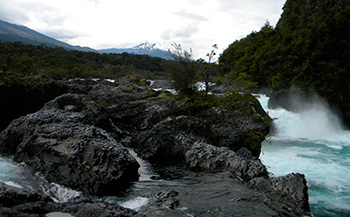
Petrohue Falls
In Puerto Varas, we were near the last-held ground of the Mapuche. The Spanish conquistadors and their descendants (plus some other Europeans) pushed the indigenous peoples who survived attacks and diseases toward the colder, less hospitable south just as we forced native tribes west. Today the Mapuche make up approximately four percent of Chile’s population, and they’re still struggling for their rights.
A Mapuche activist and culture preservationist talked to us about the Mapuche philosophy of life, government persecution for such acts as displaying their flag, and the ongoing fight to regain the land the Pinochet government took from them and awarded to his friends. The preservationist also noted that the Mapuche, by choice, have no written language. His grandparents say the words lose their true meaning on paper.
Our program director told us that eighty-five percent of Chile’s people have mestizo (mixed) blood, and that most of them deny it.
Like most other countries, Chile has a ways to go to build a true democracy. From my limited reading and observation, class constitutes a bigger problem than race, and economic and educational inequality presents one of the country’s greatest challenges. We face the same challenge.
I filtered my observations of Chile through others’ opinions and my experiences in other countries. The friendliness of the people made me root for them. The tour didn’t give me any expert knowledge, but those few days will help me understand what I read in their history and literature and what I see on the news.
—Carolyn Mulford
“Aura of Death” Published in That Mysterious Woman
Experience has taught Jessica to keep secret her ability to see character-revealing auras. When an inexplicable cloud over a murder victim’s grave leads her to a killer, her unusual perceptions pose a dilemma and place her in danger.
I tell this tale in “An Aura of Death,” one of 27 short stories that appear in That Mysterious Woman, a new Shaker of Margaritas anthology published by Mozark Press in paperback and e-book editions (available on Amazon). Among the other writers are Paula Benson, E. B. Davis, Sharon Woods Hopkins, Edith Maxwell, Harriet Sackler, and Donna Volkenaant. The writers come from around the country and tell a variety of tales.
I write few short stories, and rarely anything that includes a supernatural element, but the idea of identifying a cold-blooded murderer and having no way to prove his guilt intrigues me. So does the ability, or burden, of seeing auras, which stems from a neurological condition called synesthesia.
Maybe some day Jessica will see another disturbing aura.
—Carolyn Mulford
